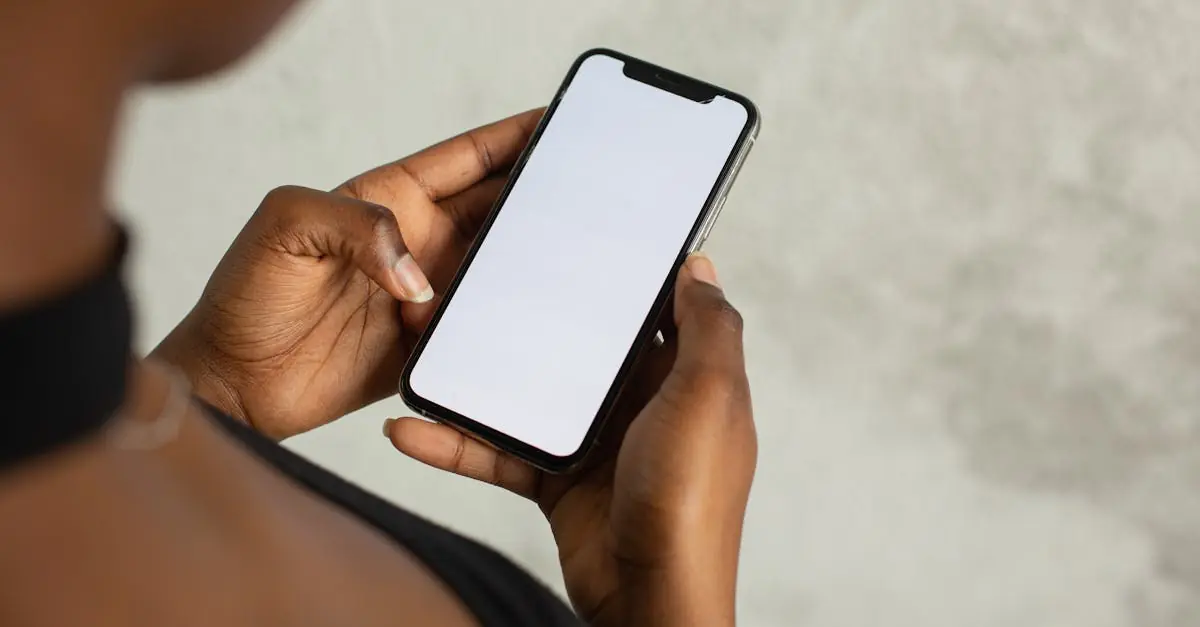Table of Contents
ToggleIn a world where calorie counting can feel like a full-time job, mobile apps swoop in like superheroes, ready to save the day. Gone are the days of scribbling down every bite on napkins or guessing how many calories are in that mysterious salad dressing. With just a tap on a screen, anyone can track their food intake, making healthy eating feel less like a chore and more like a game.
Imagine having a personal nutritionist in your pocket, guiding you through the maze of food choices with a wink and a nudge. These apps not only keep tabs on calories but also help users make smarter choices without sacrificing flavor. So why not let technology do the heavy lifting? Embrace the calorie-counting revolution and discover how easy it can be to stay on track while still enjoying life’s delicious moments.
Overview of Mobile Calorie-Counting Apps
Mobile calorie-counting apps provide users with a practical way to track their dietary habits. Features like barcode scanning simplify logging food items, enhancing user experience. By offering extensive food databases, these apps deliver accurate calorie information for meals consumed. Tools for tracking macronutrients, such as proteins and fats, empower users to make informed dietary choices.
Customization options exist within many apps, allowing users to tailor their experience according to individual health goals. Some apps include reminders, prompting users to maintain their dietary plans effectively. Social features encourage community engagement, where users can share experiences and recipes, fostering accountability.
Integration with wearable devices further enriches the tracking experience. Users can monitor their physical activity alongside calorie intake, promoting a holistic approach to health. Gamification elements found in some apps motivate users to achieve their fitness goals through challenges and rewards.
Data generated from tracking patterns helps users recognize trends in their eating habits. This analysis enables individuals to adjust their dietary practices for improved health outcomes. With ongoing updates and support, mobile calorie-counting apps continually enhance their functionalities, ensuring they meet user needs.
Popular options include MyFitnessPal, Lose It!, and Cronometer. Each of these apps offers distinct features, catering to various dietary preferences and lifestyle choices. Users can explore these apps to find one that aligns with their specific requirements, which supports sustainable health journeys.
Key Features of Mobile Calorie-Counting Apps
Mobile calorie-counting apps offer a range of features that enhance user engagement and promote healthy eating habits.
User Interface and Experience
User interfaces are crucial for ensuring seamless navigation. Clean designs facilitate easy tracking of food and calories. Color-coded elements simplify the identification of nutrient categories. Additionally, customizable layouts align with personal preferences. Tutorials and onboarding processes help new users understand app functionalities quickly. Intuitive touch controls enhance the overall experience, making it enjoyable to log meals.
Tracking Capabilities
Tracking capabilities provide detailed insights into dietary habits. Extensive food databases allow users to log items accurately. Barcode scanning features speed up the entry process, increasing convenience. Users can monitor macronutrients like carbohydrates, proteins, and fats to meet specific health goals. Automatic calculations of total calories consumed versus burned support informed decision-making. Daily summaries highlight trends, enabling users to adjust their diets as necessary.
Integration with Wearables
Integration with wearable devices strengthens health monitoring. Syncing with fitness trackers offers real-time data on activity levels and calorie expenditure. It enhances the accuracy of calorie tracking by combining input from different sources. Notifications encourage users to stay active throughout the day. Wearable data also helps tailor calorie goals based on activity levels. Such holistic approaches promote a comprehensive view of overall health, encouraging continuous improvement.
Popular Mobile Calorie-Counting Apps
Numerous mobile calorie-counting apps offer unique features and tools to assist users in their nutritional journeys. Three standout options include MyFitnessPal, Lose It!, and Cronometer.
MyFitnessPal
MyFitnessPal features an extensive food database with over 11 million foods, making it easy for users to log their meals. Users can utilize the barcode scanner for quick entry of packaged items. Analytical tools provide insights into daily nutrient intake, helping individuals make informed choices. Community forums foster social support, while personalized goals assist users in tracking progress toward their health objectives. Integration with fitness trackers further enhances the experience by tracking calories burned alongside intake.
Lose It!
Lose It! emphasizes user-friendly functionality with a simple interface that makes logging meals effortless. Customization options allow users to set personalized goals based on weight loss or maintenance targets. Extensive food databases include thousands of items, and a barcode scanner simplifies meal entry. Visual tools track progress and accomplishments, keeping users motivated. Additionally, community features promote interaction, providing encouragement through challenges and group support.
Cronometer
Cronometer stands out with a focus on micronutrient tracking alongside macronutrients. This app allows users to monitor essential vitamins and minerals, offering a comprehensive view of dietary intake. The extensive food database includes detailed nutrition information, ensuring accuracy for logged meals. Users benefit from customizable tracking options to align with specific dietary plans. Integration with other health apps supports holistic tracking, making it a valuable resource for anyone looking to optimize their nutritional habits.
Benefits of Using Mobile Calorie-Counting Apps
Mobile calorie-counting apps offer several advantages that promote healthier eating habits. Tracking food intake becomes streamlined with user-friendly interfaces, allowing individuals to log meals quickly. These apps often include barcode scanning, which simplifies the process of adding food items to daily logs.
Comprehensive food databases enhance accuracy, providing nutritional information on millions of items. Users gain access to vital information about macronutrients, which supports informed dietary choices. Integration with wearable devices augments these benefits, syncing data on activity levels and calorie expenditure for a holistic approach to health.
Gamification features motivate users through challenges and rewards, transforming calorie counting into an engaging experience. Personalization options cater to unique health goals, enabling individuals to tailor their tracking according to dietary preferences. Community support from social features fosters accountability among users, encouraging shared experiences and tips.
Data analytics functionality allows users to recognize trends in their eating habits, making it easier to adjust behaviors over time. Nutritional insights provided by apps such as MyFitnessPal, Lose It!, and Cronometer empower users to monitor progress effectively. Many users appreciate access to tutorials that facilitate swift navigation of app functionalities, enhancing the overall user experience.
With data-driven feedback, individuals can better understand their nutrition choices, ultimately leading to improved health outcomes. The convenience of having a virtual nutritionist at one’s fingertips encourages consistency, making healthy eating enjoyable. Adopting mobile calorie-counting apps represents a proactive step toward managing one’s diet and achieving sustainable health goals.
Potential Drawbacks of Mobile Calorie-Counting Apps
Not everything about mobile calorie-counting apps is positive. Privacy concerns arise as users often share personal data with these platforms. Many apps collect sensitive information, leading individuals to question how their data is used and stored.
User dependency represents another drawback. Some people may become overly reliant on these tools, potentially developing unhealthy habits surrounding food intake. This dependency can create anxiety when logs don’t align with their expectations or goals.
Accuracy issues can also impact user experience. Food databases might not always be reliable, resulting in incorrect calorie counts or missed entries. A lack of comprehensive entries may frustrate users who seek precise tracking.
The potential for discouragement exists as well. Users may encounter discouraging data if they perceive limited progress toward their health goals. This negativity might lead some to abandon the apps entirely.
Distraction emerges as another concern. Notifications and social features can divert focus from the main goal of healthy eating. This distraction may clutter the user experience and hinder effective tracking.
Lastly, subscription costs for premium features can deter potential users. Many apps offer free versions, but accessing advanced functionalities often requires payment. This cost factor might exclude individuals who can’t afford subscription fees.
Each of these drawbacks emphasizes the importance of using mobile calorie-counting apps mindfully. Understanding these limitations enables users to utilize these tools effectively while mitigating potential negative impacts.
Conclusion
Mobile calorie-counting apps are transforming the way individuals approach their nutrition. By offering convenience and personalized insights they empower users to take control of their dietary habits. With features that enhance user experience and promote community engagement these tools make healthy eating more accessible and enjoyable.
While there are potential drawbacks it’s essential for users to remain aware and mindful. The benefits often outweigh the challenges when individuals use these apps as part of a balanced approach to health. Embracing technology in nutrition can lead to informed decisions and sustainable lifestyle changes. Ultimately these apps serve as valuable allies in the journey toward better health and wellness.





